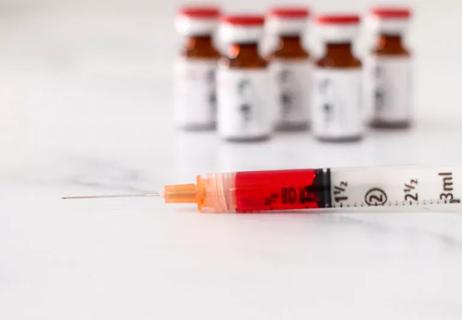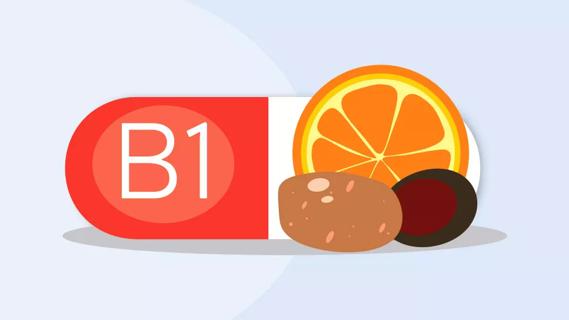Also known as pantothenic acid, vitamin B5 helps your metabolism and is found in a wide range of foods

Sometimes getting all the vitamins you need to stay healthy can feel like work. Because some vitamins can feel elusive.
Advertisement
Cleveland Clinic is a non-profit academic medical center. Advertising on our site helps support our mission. We do not endorse non-Cleveland Clinic products or services. Policy
If you don’t eat animal products, for example, getting your fair share of vitamin B12 can be a challenge. And vitamin K — for all its benefits for your heart, bones and more — can come from some rather dubious food sources.
But vitamin B5 isn’t one of those hard-to-come-by nutrients. It’s found in a range of healthy foods that we eat all the time. In fact, vitamin B5’s other name, pantothenic acid, comes from the Greek word “panto,” which means “everywhere.”
“Unless you’re living with malnutrition, it’s very unlikely you’re deficient in vitamin B5,” says registered dietitian Natalie Romito, RDN, LD.
And good thing, too, because vitamin B5 does a lot of good work for your body. What are vitamin B5’s benefits, and what foods are chock full of pantothenic acid? Let’s take a look.
Vitamin B5 is one of the eight B vitamins. And like other B vitamins, it plays an important role in several processes throughout your body. (Bonus: It also can be a helpful ingredient in your skin care and hair care products.)
“B vitamins act as coenzymes, which means they help to either create enzymes our bodies need or activate enzymes that are in your body so they can go and do their jobs,” Romito shares. “Some of those enzymes help with digesting foods and converting foods into energy that our cells can use. Others are used for functions like growing healthy blood cells, replicating DNA or preventing DNA damage.”
Advertisement
Here’s what vitamin B5 specifically does for your body.
Vitamin B5’s primary goal is to help make and break down fatty acids. That means it helps to turn the fats in the foods you eat into energy. It does that by making a compound in your body called coenzyme A, which helps turn food into energy your body can use to go about its business.
In people living with a rare genetic condition called pantothenate kinase-associated neurodegeneration (PKAN), vitamin B5 doesn’t effectively convert into coenzyme A. That can lead to serious and life-threatening loss of function. PKAN is very rare. It’s estimated to affect between 1 and 3 people per million around the world.
Some early research has suggested that high doses of one form of vitamin B5 may help people with hyperlipidemia (high cholesterol). Some studies have reported that high levels of vitamin B5 can help lower levels of LDL (“bad” cholesterol) and improve or maintain levels of HDL (“good” cholesterol).
“It’s still being studied,” Romito says. “But some research has shown that vitamin B5 impacts how lipids are processed and utilized in your body, which can lead to improvements in cholesterol.”
In one study of 120 people, researchers showed that participants who took vitamin B5 supplements had small but significant improvements in cholesterol.
While the research is promising so far, it’s still preliminary. Future studies will be needed on larger groups of people and following the effects of vitamin B5 on cholesterol for longer periods of time.
The Food and Nutrition Board at the National Academies of Sciences, Engineering and Medicine set intake recommendations for various nutrients. They recommend the following as adequate intakes of vitamin B5:
There’s no upper limit set for vitamin B5. That means there’s not enough evidence to consider high amounts of vitamin B5 to be a major health risk. But some studies have reported that having more than 10 mg per day of pantothenic acid supplements may be associated with stomach issues, like mild diarrhea.
Certain vitamins tend to be found mostly within certain food groups. When you think of vitamin C, you probably think of citrus and other brightly colored fruits and vegetables. When you think of vitamin K, dark, leafy greens may come to mind.
B5 is different in that respect. Because pantothenic acid is found in a wide range of foods and food groups.
Advertisement
So, even if you don’t eat meat. Or dairy. Or you’re picky about your veggies. Chances are you’re getting enough B5 from your plate. The National Institutes of Health goes so far as to say, “Almost all plant- and animal-based foods contain pantothenic acid in varying amounts.”
Some of the top food sources for vitamin B5 include:
| Food | Serving size | Vitamin B5 content |
|---|---|---|
| Fortified breakfast cereal | 1 serving | 5 mg |
| Cooked shitake mushrooms | 1/2 cup | 2.6 mg |
| Sunflower seeds | 1/4 cup | 2.4 mg |
| Roasted chicken breast | 3 ounces | 1.3 mg |
| Cooked bluefin tuna | 3 ounces | 1.2 mg |
| Avocado | 1/2 avocado | 1 mg |
| 2% milk | 1 cup | 0.9 mg |
| Stir-fried white mushrooms | 1/2 cup | 0.8 mg |
| Baked russet potatoes | 1 medium potato | 0.7 mg |
| Hard-boiled eggs | 1 large egg | 0.7 mg |
| Nonfat vanilla Greek yogurt | 5.3 ounces | 0.6 mg |
| Ground beef | 3 ounces | 0.6 mg |
| Roasted peanuts | 1/4 cup | 0.5 mg |
| Boiled broccoli | 1/2 cup | 0.5 mg |
| Whole-wheat pita | 1 large pita | 0.5 mg |
| Canned chickpeas | 1/2 cup | 0.4 mg |
| Brown rice | 1/2 cup | 0.4 mg |
| Oats | 1/2 cup | 0.4 mg |
| Food | ||
| Fortified breakfast cereal | ||
| Serving size | ||
| 1 serving | ||
| Vitamin B5 content | ||
| 5 mg | ||
| Cooked shitake mushrooms | ||
| Serving size | ||
| 1/2 cup | ||
| Vitamin B5 content | ||
| 2.6 mg | ||
| Sunflower seeds | ||
| Serving size | ||
| 1/4 cup | ||
| Vitamin B5 content | ||
| 2.4 mg | ||
| Roasted chicken breast | ||
| Serving size | ||
| 3 ounces | ||
| Vitamin B5 content | ||
| 1.3 mg | ||
| Cooked bluefin tuna | ||
| Serving size | ||
| 3 ounces | ||
| Vitamin B5 content | ||
| 1.2 mg | ||
| Avocado | ||
| Serving size | ||
| 1/2 avocado | ||
| Vitamin B5 content | ||
| 1 mg | ||
| 2% milk | ||
| Serving size | ||
| 1 cup | ||
| Vitamin B5 content | ||
| 0.9 mg | ||
| Stir-fried white mushrooms | ||
| Serving size | ||
| 1/2 cup | ||
| Vitamin B5 content | ||
| 0.8 mg | ||
| Baked russet potatoes | ||
| Serving size | ||
| 1 medium potato | ||
| Vitamin B5 content | ||
| 0.7 mg | ||
| Hard-boiled eggs | ||
| Serving size | ||
| 1 large egg | ||
| Vitamin B5 content | ||
| 0.7 mg | ||
| Nonfat vanilla Greek yogurt | ||
| Serving size | ||
| 5.3 ounces | ||
| Vitamin B5 content | ||
| 0.6 mg | ||
| Ground beef | ||
| Serving size | ||
| 3 ounces | ||
| Vitamin B5 content | ||
| 0.6 mg | ||
| Roasted peanuts | ||
| Serving size | ||
| 1/4 cup | ||
| Vitamin B5 content | ||
| 0.5 mg | ||
| Boiled broccoli | ||
| Serving size | ||
| 1/2 cup | ||
| Vitamin B5 content | ||
| 0.5 mg | ||
| Whole-wheat pita | ||
| Serving size | ||
| 1 large pita | ||
| Vitamin B5 content | ||
| 0.5 mg | ||
| Canned chickpeas | ||
| Serving size | ||
| 1/2 cup | ||
| Vitamin B5 content | ||
| 0.4 mg | ||
| Brown rice | ||
| Serving size | ||
| 1/2 cup | ||
| Vitamin B5 content | ||
| 0.4 mg | ||
| Oats | ||
| Serving size | ||
| 1/2 cup | ||
| Vitamin B5 content | ||
| 0.4 mg |
Most healthy people will easily get the vitamin B5 they need in their diets — no supplement needed.
People living with PKAN or who don’t get the nutrition their bodies need can be at risk for deficiency in pantothenic acid and many other nutrients their bodies need. That can include people who:
If you’re living with a condition that causes undernutrition, talk with a healthcare provider to best address your personal nutritional goals and needs.
For everyone else, Romito advises against vitamin B5 supplements.
“Vitamin B5 is ubiquitous in our food supply,” she reinforces. “And we don’t, as of now, have data to suggest that people benefit from more vitamin B5 than what’s typically in our diets. Focus on eating a varied diet, and you’ll get what you need.”
Advertisement
Learn more about our editorial process.
Advertisement

Though it was once used as a cholesterol-lowering medication, niacin is no longer a recommended treatment

Some protein-containing foods are known to be good sources of biotin — but there are also likely other foods that just haven’t been studied yet

This essential nutrient helps convert food into energy, but don’t expect wonders for your nails and hair

This important B vitamin has benefits for your heart, brain and skin

Taking supplements with biotin can cause inaccurate lab test results

If you have low B12 or a true deficiency, these shots can work wonders

Pantothenol is a powerful moisturizer and can help repair damaged skin and hair

Getting enough thiamine in your diet can protect your heart, brain and nervous system

Start having sex about 72 hours before ovulation, then at least every other day during your fertile window

Attachment theory suggests that your earliest relationships shape connections throughout your life

It isn’t a recognized mental health disorder, but research shows that problematic social media use can negatively affect your mental health, self-esteem and sleep